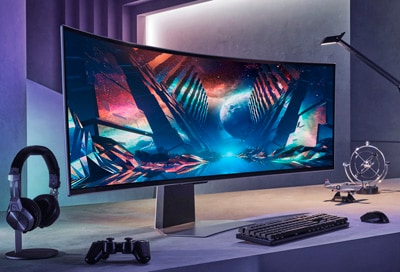Samsung monitor: the image's color is off or it's too dark.
If you're experiencing difficulty in achieving clear visuals or noticing distorted or excessively dark colors on your screen, it may be necessary to make adjustments. Fine-tune the Brightness, Contrast, and Color settings to attain the optimal display balance for your monitor. Additionally, consider running a diagnostic test to ensure optimal performance

Check for automatic adjustments in brightness, contrast, and color tone settings on your monitor. For instance, features like Ambient Light Detection (under General > Eco solution) or Adaptive Picture (under Picture > Eye Care) on our Smart Monitor line dynamically adjust these settings. If you prefer manual control (see steps 2 and 3), ensure any overriding settings are disabled. If adjustments remain disabled, check for blocking settings with keywords like
- Adaptive
- Dynamic
- Eco
- Eye care
- Eye saver
Brightness adjusts overall lightness, while Contrast enhances the distinction between light and dark areas. Experiment with both settings to achieve your desired picture quality. Follow these tips:
- If all your lights tend to blur together and all your darks tend to blur together, lower your Contrast.
- If you have a hard time telling light from dark, increase your Contrast.
- If all your lights tend to blur together, and your darks don't blur together but are too light, then reduce your Brightness.
- And finally, if all your darks tend to blur together, and your lights don't blur together but they are too dark, then increase your Brightness.
If colors seem inconsistent or distorted, adjust the Color and Gamma settings for better clarity. Unlike Brightness and Contrast, Gamma helps with the visibility of light and dark colors.
Access the On-Screen Display for these settings and follow these tips:
- If the overall saturation level is too intense, choose the options for Red, Green, or Blue to adjust the individual level for each color.
- Color Tone includes different color temperatures that may be easier on your eyes.
- Choose Cool to make whites appear blue.
- Choose Normal (or Standard) to keep whites as they are.
- Choose Warm to make whites appear reddish or pinkish.
- Choose Custom to alter the settings based on your preferences.
- Gamma measurements correspond to the screen’s illumination. The proper Gamma setting will create a richer image.
- If it's hard to see bright colors, you should decrease the Gamma.
- If it's hard to see dark colors, you should increase the Gamma.
A diagnostic test will determine if the monitor is functioning properly. To perform one, open the Menu on your monitor, and then select System. Select Self Diagnosis. You will be prompted to test your screen.
Select OK, and view the screen. Avoid turning off the monitor or changing the input source while the test is running. You can select either No, Yes, or Show Again when asked to view the test screen again.
- Select No if there were no issues on the screen during the test.
- Select Yes if you noticed issues during the test. You'll be directed to contact a Samsung Call Center or Samsung Support for further help. Make sure you have your monitor’s model code, software version, and serial number ready when calling.
- Select Show Again if you’d like to check the test screen a second time.
Note: If you require further assistance, please contact our Contact Center experts.
Thank you for your feedback!
Please answer all questions.